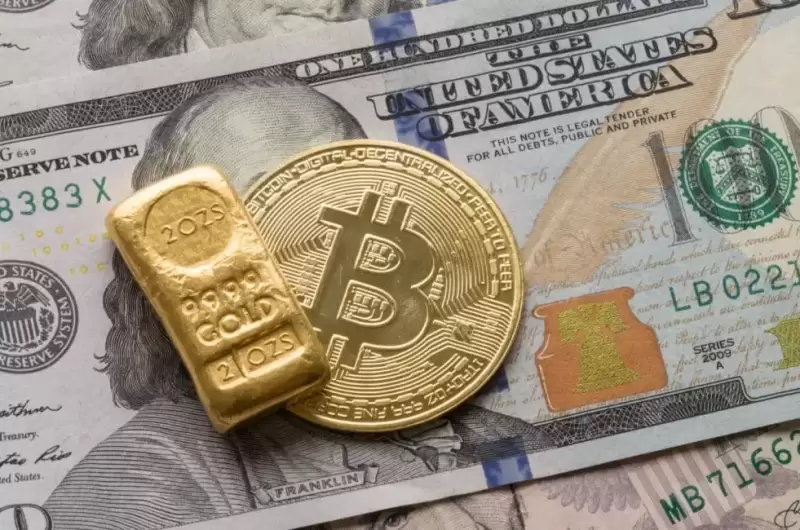 |
|
 |
|
 |
|
 |
|
 |
|
 |
|
 |
|
 |
|
 |
|
 |
|
 |
|
 |
|
 |
|
 |
|
 |
|
Cryptocurrency News Articles
Bitcoin's History During Market Turmoil Does Not Necessarily Encourage Its Chances of Success This Time
Apr 03, 2025 at 03:14 am
As the global economy anxiously awaits President Trump's tariff announcements, some traders are already thinking about worst-case scenarios.

As the global economic landscape anxiously anticipates President Trump's tariff announcements, some traders are already contemplating worst-case scenarios. In today's turbulent climate, that notion evokes stagflation—a troublesome economic condition characterized by high inflation and low growth.
"Tariffs are a staglationary shock to the economy. They reduce growth and raise inflation," explains Zach Pandl, head of research at digital asset manager Grayscale and a former senior economist at Goldman Sachs. "What we don't know is the mix in terms of stagnation and inflation. At the moment, markets are more focused on stagnation, but we very well may see more inflation persistence over time."
For many investors, especially those with bitcoin exposure, a key question is how this asset class will perform in such an environment. After all, the last period of stagflalion, at least in the U.S., occurred in the 1970s due to the Arab oil embargo of the U.S. These are questions that have not needed to be addressed for 50 years—long before Satoshi Nakamoto wrote the famous Bitcoin white paper.
Bitcoin's history during periods of market turmoil isn't necessarily encouraging. During the market recession in 2020 at the outset of the COVID pandemic, the asset briefly dropped below $4,000. At other times of market stress, such as the unwinding of the Japanese yen carry trade in August 2024 or the broader market downturn in 2022, it behaved more like a speculative asset than the store of value that it is purported to be.
However, there is reason to be cautiously optimistic about bitcoin's chances this time, Pandl says. "Much like the 1970s was a breakout period for gold [which had an average annualized 31% return], I believe that the coming decade will be a breakout period for Bitcoin. It's the right macro asset at the right time, and we have significant improvements in market structure creating more investor access to the product."
Stagflation = Gold Rush
Stagflation is an exceptionally rare occurrence, even during poor economic climes. The U.S. has had 16 recessions in the past 100 years, but only one period of stagflation: the 1970s. And given the economy's ongoing resilience, it's not a material concern yet.
"Although there are concerns about stagflation, we're nowhere near what occurred in the Seventies. At that period of time, there was a period of excess in the Sixties, the Vietnam War, and then you also had this exogenous shock of the Arab oil embargoes. The price of energy skyrocketed and the nation just was not ready for it," says Steve Sosnick, Chief Strategist at Interactive Brokers. Sosnick went on to point out how, at 4% unemployment, the U.S. economy remains in an enviable position. Also, inflation, which peaked to 1970s levels just a couple of years ago, is now down to 2-3%.
But even according to Sosnick, the threshold for stagflation does not have to meet the trauma of the 1970s. "If you want to define stagflation as a period involving a stagnating economy and higher prices, then I think it's hardly an idle concern," he says.
So how did markets react to the shock of the oil embargo, which started in 1973? They bought gold and moved away from stocks, as indicated in the chart below. The S&P 500 only gained 26.99% for the entire decade, an annualized growth rate of a little over 2%. Considering the double-digit inflation of that period, anyone holding shares in those stocks lost money in real terms. Conversely, gold offered 30% annualized returns for most of the decade, and then it surged more than 500% at the tail end of the decade after concerns about persistent inflation really took hold.
This inverse relationship between gold and stocks has been consistent through the decades. The only real exception was when they rose at the same rate during the COVID outbreak as the Federal Reserve injected trillions of dollars into the economy and buttressed virtually every asset class in the world.
It is even holding true again in 2025 as concerns about the impact of President Trump's erratic tariff policies spook markets. Gold continues to set record highs, and it is currently priced at $3,171 per oz, while bitcoin is trailing both the S&P 500 and tech-heavy Nasdaq 100.
Bitcoin: Finally a Safe Haven?
Will things be different this time? It is important to
Disclaimer:info@kdj.com
The information provided is not trading advice. kdj.com does not assume any responsibility for any investments made based on the information provided in this article. Cryptocurrencies are highly volatile and it is highly recommended that you invest with caution after thorough research!
If you believe that the content used on this website infringes your copyright, please contact us immediately (info@kdj.com) and we will delete it promptly.
-

-

-

-

-

-

- Mara Holdings (MARA) Weathers the Bitcoin Price Volatility Storm by Increasing Blocks Won by 17% Month-over-Month
- Apr 03, 2025 at 11:40 pm
- Despite the recent volatility in Bitcoin prices, the most recent caused by Trump's tariff announcement, some of the top miners are weathering the storm, among them Mara Holdings.
-

-

-



























































